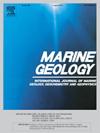沿岸系统中磷埋藏和沉积后成岩作用对冰期后气候变化的响应
IF 2.2
3区 地球科学
Q2 GEOSCIENCES, MULTIDISCIPLINARY
引用次数: 0
摘要
沿岸系统中磷(P)的埋藏和成岩作用决定了流入海洋的活性磷通量,影响着初级生 产力和营养元素循环。为了了解磷在沿岸地区的归宿及其与冰期后气候变化的关系,我们测定了中国东部钱塘江河口沉积物岩芯中的磷种类、氧化铁(氧水)、主要元素、营养元素(碳和氮)以及维安石矿物特征。我们的研究结果表明,钱塘江河口系统的钾循环主要受冰期后海平面变化的控制。在河道和古河口沉积物中,铁结合磷(PFe)占主导地位,占总磷库的79%,主要以维安石的形式存在,特别是在河口-海洋过渡区以下富集。这种富集与公元前 8.5 ka 年左右海洋断裂导致底层水硫酸盐浓度增加和沉积速率降低有关,促进了甲烷的持续厌氧氧化和铁氧体的还原溶解。与此相反,在浅海和现代河口沉积中,与 Ca 相关的 P(主要是碳酸盐氟磷灰石)的形成以 PFe 和有机 P 为代价,在高海平面时期成为主要的 P 汇。高 PFe 沉积事件与小干纪-全新世过渡时期的古洪水事件有关。洪水驱动的表层沉积物富氧促进了铁氧体和钾的共沉淀,明显降低了 PFe 分异中的铁/钾比率。我们的研究突出了冰期后气候变化通过海平面波动、环境扰动和突变气候事件对沿岸 P 循环的长期影响。本文章由计算机程序翻译,如有差异,请以英文原文为准。
Response of phosphorus burial and post-depositional diagenesis to postglacial climate change in the coastal system
The phosphorus (P) burial and diagenesis in coastal systems determine the reactive P flux to the ocean, influencing primary productivity and nutrient element cycles. To understand the fate of P in coastal areas and its association with postglacial climate change, we determined P species, Fe-(oxyhydr)oxides (Fe-oxides), major elements, nutrient elements (C and N), and vivianite minerals characteristics in sediment cores from the Qiantang River (QR) estuary in eastern China. Our findings reveal that the P cycle was predominantly controlled by postglacial sea-level changes in the QR estuarine system. Fe-bound P (PFe) dominates in fluvial and paleo-estuarine sediments, comprising ∼79 % of total P pool, which mainly exists in the form of vivianite, particularly enriched below the estuarine-marine transition. This enrichment is linked to increased bottom-water sulfate concentrations and reduced sedimentation rates in response to marine transgression around 8.5 ka BP, promoting the sustained anaerobic oxidation of methane and reductive dissolution of Fe-oxides. In contrast, Ca-associated P (mostly carbonate fluorapatite) formed at the expense of PFe and organic P in shallow marine and modern estuarine deposits, acting as a major P sink during high sea-level episodes. The high PFe deposition event is linked to a paleo-flood event at the Younger Dryas-Holocene transition. Flood-driven surface sediments oxygenation facilitated the coprecipitation of Fe-oxides and P, notably lowering Fe/P ratio in PFe speciation. Our work highlights the long-term impact of postglacial climate change on the coastal P cycle through sea-level fluctuation, environmental perturbation, and abrupt climate events.
求助全文
通过发布文献求助,成功后即可免费获取论文全文。
去求助
来源期刊

Marine Geology
地学-地球科学综合
CiteScore
6.10
自引率
6.90%
发文量
175
审稿时长
21.9 weeks
期刊介绍:
Marine Geology is the premier international journal on marine geological processes in the broadest sense. We seek papers that are comprehensive, interdisciplinary and synthetic that will be lasting contributions to the field. Although most papers are based on regional studies, they must demonstrate new findings of international significance. We accept papers on subjects as diverse as seafloor hydrothermal systems, beach dynamics, early diagenesis, microbiological studies in sediments, palaeoclimate studies and geophysical studies of the seabed. We encourage papers that address emerging new fields, for example the influence of anthropogenic processes on coastal/marine geology and coastal/marine geoarchaeology. We insist that the papers are concerned with the marine realm and that they deal with geology: with rocks, sediments, and physical and chemical processes affecting them. Papers should address scientific hypotheses: highly descriptive data compilations or papers that deal only with marine management and risk assessment should be submitted to other journals. Papers on laboratory or modelling studies must demonstrate direct relevance to marine processes or deposits. The primary criteria for acceptance of papers is that the science is of high quality, novel, significant, and of broad international interest.
 求助内容:
求助内容: 应助结果提醒方式:
应助结果提醒方式:


